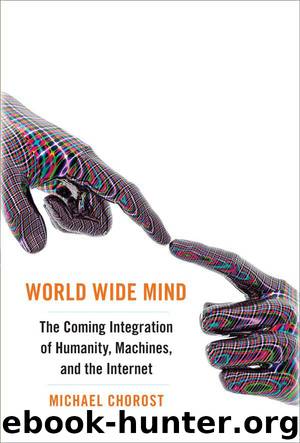World Wide Mind: The Coming Integration of Humanity, Machines, and the Internet by Michael Chorost

Author:Michael Chorost [Chorost, Michael]
Language: eng
Format: azw3, epub
Publisher: Free Press
Published: 2011-02-15T05:00:00+00:00
The Physical Engineering of a Rig
At this point we can outline the basis of a working mind-to-mind communications technology. Leaving aside questions such as how one fits it all inside the body and the far from trivial challenge of FDA approval, it could look like this.
• One could read neural activity at the level of individual memories by observing neurons altered with a green fluorescent protein (GFP)–based indicator of neural activity.
• One could trigger neural activity at the level of individual memories with blue light activating channelrhodopsin-doped neurons.
• One could inhibit neural activity with yellow light activating halorhodopsin-doped neurons.
• One could measure levels of dopamine, oxytocin, and other neurochemicals by adding genes that would cause neurons to fluoresce when they turn on the genes that manufacture those neurotransmitters. At the Howard Hughes Medical Institute, researchers have detected glutamate and serotonin production in this way. Andrew Hires told me in an email, “You could potentially have each neurotransmitter assigned to a different color GFP [green fluorescent protein] variant. Green for calcium/ neural activity, orange for glutamate, red for GABA, blue for dopamine, yellow for serotonin…”
• One could interpret the data using intelligent computers, which would learn the user’s hierarchies of prediction (that is, perception and memory). These computers would probably have many terabytes of memory. They could be implanted in the body or worn on it. In either case they would use radio to communicate with the hardware in the body.
• One could transmit neural activity via the Internet, using wireless networking.
• One could power the internal components with radio-frequency induction, the way cochlear implants are powered now. External components could be powered by batteries.
To be sure, this would require a lot of work on a human body. We’d have to genetically alter parts of the brain with modified viruses and insert LED panels under the skull. The computational elements could be countersunk into the skull under the skin, as with cochlear implants. Getting power in and data out could be done the way cochlear implants do it too, using radio-frequency inductive current generated by external devices magnetically sticking to the head. Those devices, in turn, would have wireless connections to the Internet.
As for powering the system, batteries might be enough, but they could be augmented with more exotic sources of power. Engineers have speculated for years about drawing power from the body itself. With piezoelectric generators tucked in the heels of shoes, a 165-pound man could, in theory, generate 6.2 watts of power by walking. (Piezoelectric materials emit electrical current when squeezed.) That’s about enough energy to power one and a half night-lights as long as the man keeps walking. For comparison, my cochlear implants draw far less power than that, just .075 watts apiece. So it is conceptually feasible to power World Wide Mind circuitry by harvesting energy from the body. Internal batteries could be recharged by radio-frequency induction through the skin, just the way my headpiece uses radio to deliver power to my internal circuitry.
Such a system isn’t practically feasible yet.
Download
World Wide Mind: The Coming Integration of Humanity, Machines, and the Internet by Michael Chorost.epub
This site does not store any files on its server. We only index and link to content provided by other sites. Please contact the content providers to delete copyright contents if any and email us, we'll remove relevant links or contents immediately.
Sapiens: A Brief History of Humankind by Yuval Noah Harari(13979)
The Tidewater Tales by John Barth(12391)
Mastermind: How to Think Like Sherlock Holmes by Maria Konnikova(6931)
Do No Harm Stories of Life, Death and Brain Surgery by Henry Marsh(6683)
The Thirst by Nesbo Jo(6432)
Why We Sleep: Unlocking the Power of Sleep and Dreams by Matthew Walker(6347)
Life 3.0: Being Human in the Age of Artificial Intelligence by Tegmark Max(5181)
Sapiens by Yuval Noah Harari(5116)
The Longevity Diet by Valter Longo(4854)
The Body: A Guide for Occupants by Bill Bryson(4576)
The Rules Do Not Apply by Ariel Levy(4520)
The Immortal Life of Henrietta Lacks by Rebecca Skloot(4247)
Why We Sleep by Matthew Walker(4190)
Animal Frequency by Melissa Alvarez(4147)
Yoga Anatomy by Kaminoff Leslie(4100)
The Hacking of the American Mind by Robert H. Lustig(4080)
All Creatures Great and Small by James Herriot(3980)
Barron's AP Biology by Goldberg M.S. Deborah T(3941)
Double Down (Diary of a Wimpy Kid Book 11) by Jeff Kinney(3919)
